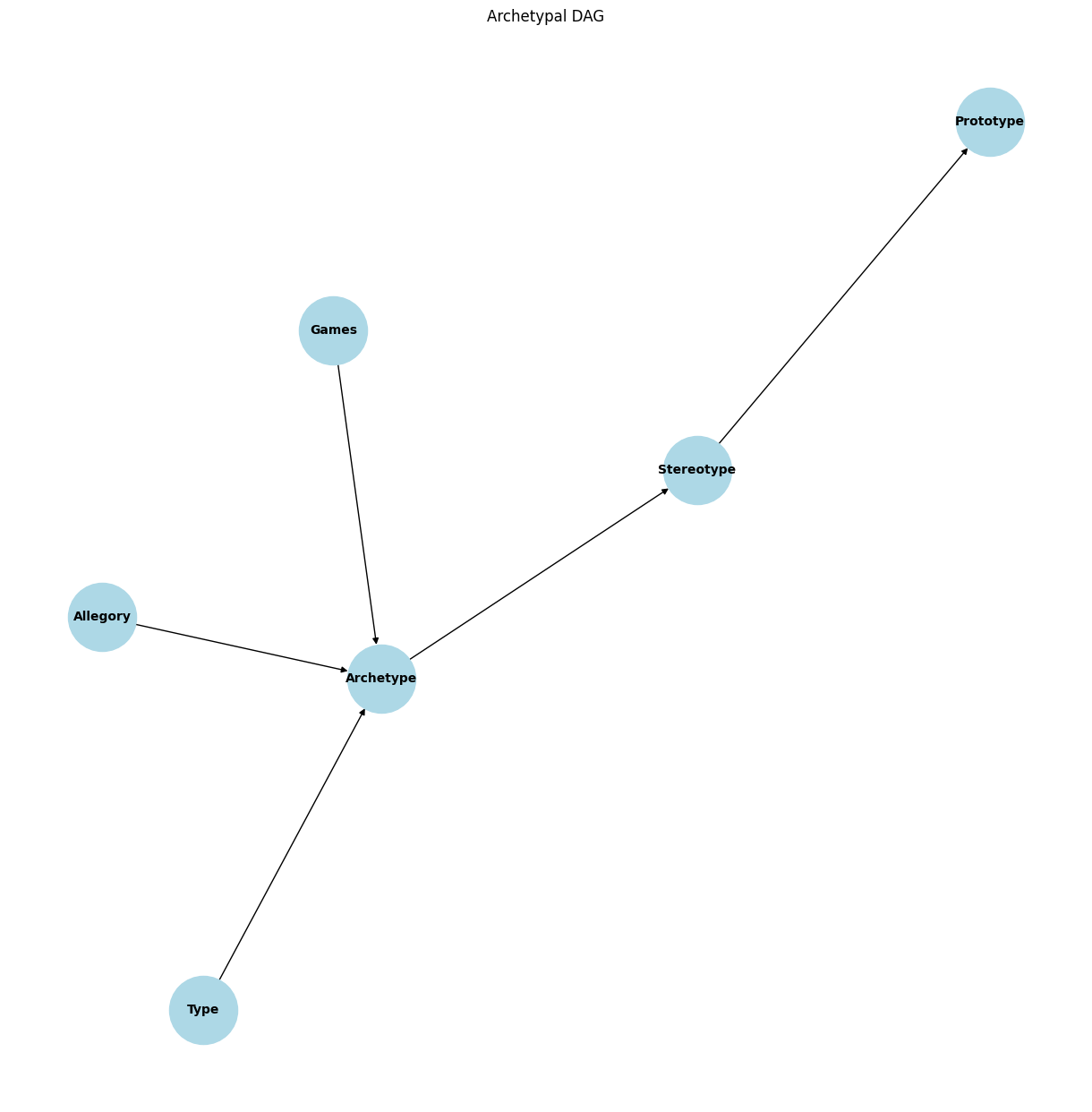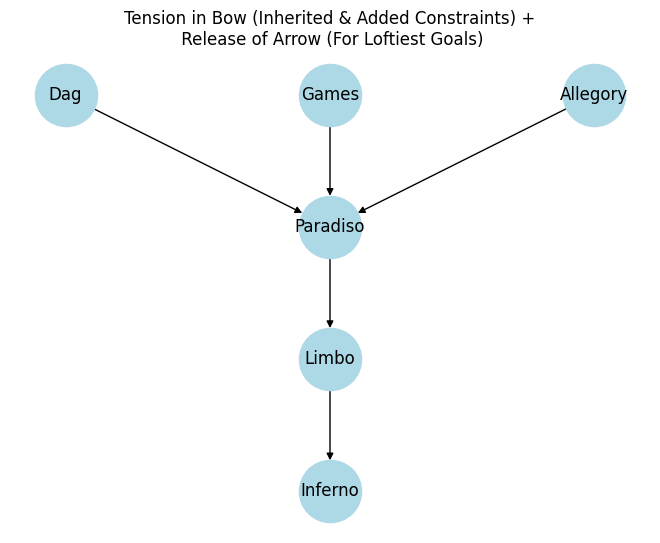Chapter 2#
1. Games, σ
\
2. Allegory, Ψ -> 4. Archetype, Δ -> 5. Stereotype, τ -> 6. Prototype, Ω
/
3. Type, ε
Show code cell source
import networkx as nx
import matplotlib.pyplot as plt
# Creating a simplified directed acyclic graph (DAG) based on the clarified structure
G_simplified_dag = nx.DiGraph()
# Adding nodes
nodes_simplified = [
"Type",
"Games",
"Allegory",
"Archetype",
"Stereotype",
"Prototype",
# "Comical",
# "Tragical",
# "Historical"
]
# Adding edges based on the clarified structure
edges_simplified = [
("Allegory", "Archetype"),
("Type", "Archetype"),
("Games", "Archetype"),
("Archetype", "Stereotype"),
("Stereotype", "Prototype"),
# ("Prototype", "Comical"),
# ("Prototype", "Tragical"),
# ("Prototype", "Historical")
]
# Adding the nodes and edges to the new simplified DAG
G_simplified_dag.add_nodes_from(nodes_simplified)
G_simplified_dag.add_edges_from(edges_simplified)
# Plotting the simplified DAG
plt.figure(figsize=(12, 12))
pos_simplified = nx.spring_layout(G_simplified_dag, seed=2)
nx.draw(G_simplified_dag, pos=pos_simplified, with_labels=True, node_color="lightblue", node_size=3000, edge_color="black", linewidths=1, font_size=10, font_weight="bold", arrows=True)
plt.title("Archetypal DAG")
plt.show()


Fig. 35 Directed Acyclic Graph (DAG). A graph where each edge has a direction, and no cycles exist, meaning you cannot start at one vertex, follow the directed edges, and return to the same vertex. This structure is important for representing processes where certain events or tasks depend on the completion of others. For example, in project management, tasks can be represented as nodes, with directed edges indicating dependencies between them, and the acyclic property ensures no task depends on itself. DAGs are widely used in computer science, including version control systems like Git (where commits are nodes and edges represent their order), task scheduling, and blockchain technologies such as IOTA, which track transactions without needing a linear chain. The key feature of a DAG is its ability to structure dependencies or relationships in a way that prevents circular logic, making it essential for systems that require clear sequencing or progression.#
Inherited Constraints:
Pouvoir Directed Acyclic Graph (DAG): Strict adherence to this structure. No cycles, no bidirectional arrows. The essential inherited framework consists of three critical elements: directed, acyclic, graph. Deviations (like backward or cyclic arrows) are unacceptable.
Savoir Game Theory: Introduce game theory to enhance DAGs with TGIF: time, iteration, fractal geometry, and feedback-loops. Incorporated these to navigate through complexity without violating the DAG structure & constraints it implies. Iterative
roundsof games enable dynamic movement within the graph.Voir TGIF (Time, Geometry, Iteration, Feedback): These elements add strategic depth while maintaining the core structure of the DAG. They allow for complexity and
cyberneticsystems that avoid the pitfalls of other frameworks. They are also analogous to layers of neural networks, where the output of one serves as input to the next. And its thus reasonable to use this approach to describe cognitive processes.
Added Constraints:
Types:
Extraordinary “tension in the bow” from these inherited ways of seeing, thinking & expressing. Then we’ve added our “personal touch” of constraints, giving us latent energy to aim “our arrow” at the loftiest goals. Through it all, we dance in chains as the freest and daintiest of spirits, even capable of leaping from peak-to-peak. Sing, O muse, of the factors, mediators, and trajectories emerging from all of this:
Archetypes
Stereotypes
Prototypes
With these three we’d address the collective, group, and personal
arcsof virtually any story whether it be historical, comical, or tragical
Show code cell source
import networkx as nx
import matplotlib.pyplot as plt
# Create a directed graph (DAG)
G = nx.DiGraph()
# Add nodes and edges based on the neuron structure
G.add_edges_from([(1, 4), (2, 4), (3, 4), (4, 5), (5, 6)])
# Define positions for each node
pos = {1: (0, 2), 2: (1, 2), 3: (2, 2), 4: (1, 1), 5: (1, 0), 6: (1, -1)}
# Labels to reflect parts of a neuron
labels = {
1: 'Dag',
2: 'Games',
3: 'Allegory',
4: 'Paradiso',
5: 'Limbo',
6: 'Inferno'
}
# Draw the graph with neuron-like labels
nx.draw(G, pos, with_labels=True, labels=labels, node_size=2000, node_color='lightblue', arrows=True)
plt.title("Tension in Bow (Inherited & Added Constraints) +\n Release of Arrow (For Loftiest Goals)")
plt.show()


Fig. 36 Dancing in Chains. In the case of every Greek artist, poet, or writer we must ask: What is the new constraint which he imposes upon himself and makes attractive to his contemporaries, so as to find imitators? For the thing called “invention” (in metre, for example) is always a self-imposed fetter of this kind. “Dancing in chains”—to make that hard for themselves and then to spread a false notion that it is easy—that is the trick that they wish to show us. Even in Homer we may perceive a wealth of inherited formulæ and laws of epic narration, within the circle of which he had to dance, and he himself created new conventions for them that came after. This was the discipline of the Greek poets: first to impose upon themselves a manifold constraint by means of the earlier poets; then to invent in addition a new constraint, to impose it upon themselves and cheerfully to overcome it, so that constraint and victory are perceived and admired. We can now freely talk about the “fall” of man from Eden: from blissful ignorance to yearning eternally-recurrently for more complete information, knowledge, … truth! Look to those cherubs in The School of Athens & contrast them with the intellectuals, steeped in a futile effort to accumulate information, knowledge, and approach the – TRUTH! Information is a weight and burden of untold magnitude, dragging humanity down to the depths of hell.#

